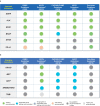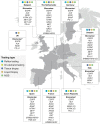Expert opinion on NSCLC small specimen biomarker testing - Part 2: Analysis, reporting, and quality assessment
- PMID: 35857103
- PMCID: PMC9297263
- DOI: 10.1007/s00428-022-03344-1
Expert opinion on NSCLC small specimen biomarker testing - Part 2: Analysis, reporting, and quality assessment
Abstract
The diagnostic work-up for non-small cell lung cancer (NSCLC) requires biomarker testing to guide therapy choices. This article is the second of a two-part series. In Part 1, we summarised evidence-based recommendations for obtaining and processing small specimen samples (i.e. pre-analytical steps) from patients with advanced NSCLC. Here, in Part 2, we summarise evidence-based recommendations relating to analytical steps of biomarker testing (and associated reporting and quality assessment) of small specimen samples in NSCLC. As the number of biomarkers for actionable (genetic) targets and approved targeted therapies continues to increase, simultaneous testing of multiple actionable oncogenic drivers using next-generation sequencing (NGS) becomes imperative, as set forth in European Society for Medical Oncology guidelines. This is particularly relevant in advanced NSCLC, where tissue specimens are typically limited and NGS may help avoid tissue exhaustion compared with sequential biomarker testing. Despite guideline recommendations, significant discrepancies in access to NGS persist across Europe, primarily due to reimbursement constraints. The use of increasingly complex testing methods also has implications for the reporting of results. Molecular testing reports should include clinical interpretation with additional commentary on sample adequacy as appropriate. Molecular tumour boards are recommended to facilitate the interpretation of complex genetic information arising from NGS, and to collaboratively determine the optimal treatment for patients with NSCLC. Finally, whichever testing modality is employed, it is essential that adequate internal and external validation and quality control measures are implemented.
Keywords: Best practice; External quality assessment; Liquid biopsy; Molecular diagnostics; Next-generation sequencing; Non-small cell lung carcinoma.
© 2022. The Author(s).
Conflict of interest statement
FP-L has provided consultancy for AbbVie, Amgen, AstraZeneca, Bayer, BMS, Clovis, Daiichi Sankyo, Diaceutics, Eli Lilly, Illumina, Invitae, MSD, Novartis, Pfizer, Roche, and Ventana, and has received research grants from AbbVie, AstraZeneca, Bayer, BMS, Illumina, MSD, and Roche. KMK has provided consultancy for AbbVie, Amgen, AstraZeneca, Bayer, Boehringer Ingelheim, Bristol-Myers Squibb, Diaceutics, Eli Lilly, Merck Serono, Merck Sharp & Dohme, Novartis, Pfizer, Roche, and Ventana. PG has provided consultancy for AbbVie, Amgen, AstraZeneca, Bayer, Boehringer Ingelheim, Bristol-Myers Squibb, GlaxoSmithKline, Janssen, Eli Lilly, Merck Sharp & Dohme, Novartis, Pfizer, Roche, and Takeda. She has been a speaker for AstraZeneca, Boehringer Ingelheim, Bristol-Myers Squibb, Janssen, Merck Sharp & Dohme, Novartis, Pfizer, Roche, and Takeda. ET has received honoraria from Amgen, Bayer, BMS, MSD, Pfizer, Roche, and Takeda, and grants to VU Medical Center from AbbVie and Pfizer. ED has received grants from Amgen, AstraZeneca, and Pfizer. NN has received speaker’s fees from and/or participated in advisory boards for AstraZeneca, Bayer, Biocartis, BMS, Eli Lilly, Illumina, Incyte, Novartis, Merck, MSD, Qiagen, Roche, Sanofi, and Thermo Fisher; and financial support for research projects from AstraZeneca, Biocartis, Blueprint, Illumina, Merck, QIAGEN, Roche, and Thermo Fisher. SJP has received honoraria from AstraZeneca, and grants from Amgen, AstraZeneca, and Merck. JF has provided consultancy for Eli Lilly. JK is employed by Amgen and has stocks/shares in Amgen. DdR is employed by Amgen. AR has received honoraria from Amgen, AstraZeneca, BMS, Boehringer Ingelheim, MSD, Novartis, Pfizer, and Roche, and grants from AstraZeneca and Pfizer. HM has provided consultancy for AstraZeneca, Bayer, BMS, Diaceutics, and Roche, and has received research grants from Roche.
Figures




Similar articles
-
Utility of incorporating next-generation sequencing (NGS) in an Asian non-small cell lung cancer (NSCLC) population: Incremental yield of actionable alterations and cost-effectiveness analysis.Lung Cancer. 2020 Jan;139:207-215. doi: 10.1016/j.lungcan.2019.11.022. Epub 2019 Nov 26. Lung Cancer. 2020. PMID: 31835042
-
Standardized and simplified reporting of next-generation sequencing results in advanced non-small-cell lung cancer: Practical indications from an Italian multidisciplinary group.Crit Rev Oncol Hematol. 2024 Jan;193:104217. doi: 10.1016/j.critrevonc.2023.104217. Epub 2023 Nov 30. Crit Rev Oncol Hematol. 2024. PMID: 38040072 Review.
-
The evolving landscape of biomarker testing for non-small cell lung cancer in Europe.Lung Cancer. 2021 Apr;154:161-175. doi: 10.1016/j.lungcan.2021.02.026. Epub 2021 Feb 22. Lung Cancer. 2021. PMID: 33690091 Review.
-
Liquid Biopsy Versus Tissue Biopsy to Determine Front Line Therapy in Metastatic Non-Small Cell Lung Cancer (NSCLC).Clin Lung Cancer. 2023 Mar;24(2):120-129. doi: 10.1016/j.cllc.2022.11.007. Epub 2022 Nov 25. Clin Lung Cancer. 2023. PMID: 36585341
-
Implementing Genomic Testing for Lung Cancer Into Routine Clinical Practice - The Welsh Experience.Clin Oncol (R Coll Radiol). 2022 Nov;34(11):716-723. doi: 10.1016/j.clon.2022.08.025. Epub 2022 Sep 8. Clin Oncol (R Coll Radiol). 2022. PMID: 36088167
Cited by
-
Unmet needs in EGFR exon 20 insertion mutations in Central and Eastern Europe: reimbursement, diagnostic procedures, and treatment availability.BMC Proc. 2024 Jan 18;18(Suppl 3):2. doi: 10.1186/s12919-023-00287-6. BMC Proc. 2024. PMID: 38233854 Free PMC article.
-
A Paradigm Shift in Non-Small-Cell Lung Cancer (NSCLC) Diagnostics: From Single Gene Tests to Comprehensive Genomic Profiling.Cancer Inform. 2024 Apr 5;23:11769351241243243. doi: 10.1177/11769351241243243. eCollection 2024. Cancer Inform. 2024. PMID: 38586547 Free PMC article.
-
Pathogenesis to management of hepatocellular carcinoma.Genes Cancer. 2022 Dec 13;13:72-87. doi: 10.18632/genesandcancer.226. eCollection 2022. Genes Cancer. 2022. PMID: 36533190 Free PMC article. Review.
-
A Real-World Experience from a Single Center (LPCE, Nice, France) Highlights the Urgent Need to Abandon Immunohistochemistry for ROS1 Rearrangement Screening of Advanced Non-Squamous Non-Small Cell Lung Cancer.J Pers Med. 2023 May 10;13(5):810. doi: 10.3390/jpm13050810. J Pers Med. 2023. PMID: 37240980 Free PMC article.
-
Real-World Performance of the EasyPGX® Ready Epidermal Growth Factor Receptor Assay for Genomic Testing of Non-Small Cell Lung Cancer Samples.Biomedicines. 2025 Mar 28;13(4):814. doi: 10.3390/biomedicines13040814. Biomedicines. 2025. PMID: 40299437 Free PMC article.
References
-
- European Society for Medical Oncology (ESMO) (2020) Metastatic non-small-cell lung cancer: ESMO cinical practice guidelines for diagnosis, treatment and follow-up. Available from: https://www.esmo.org/content/download/347819/6934778/1/ESMO-CPG-mNSCLC-1.... (cited 2021 25 November)
-
- Lindeman NI, Cagle PT, Aisner DL, Arcila ME, Beasley MB, Bernicker EH, Colasacco C, Dacic S, Hirsch FR, Kerr K, Kwiatkowski DJ, Ladanyi M, Nowak JA, Sholl L, Temple-Smolkin R, Solomon B, Souter LH, Thunnissen E, Tsao MS, Ventura CB, Wynes MW, Yatabe Y. Updated molecular testing guideline for the selection of lung cancer patients for treatment with targeted tyrosine kinase inhibitors: guideline from the College of American Pathologists, the International Association for the Study of Lung Cancer, and the Association for Molecular Pathology. J Mol Diagn. 2018;20:129–159. doi: 10.1016/j.jmoldx.2017.11.004. - DOI - PubMed
-
- Lester J, Escriu C, Khan S, Hudson E, Mansy T, Conn A, Chan S, Powell C, Brock J, Conibear J, Nelless L, Nayar V, Zhuo X, Durand A, Amin A, Martin P, Zhang X, Pawar V. Retrospective analysis of real-world treatment patterns and clinical outcomes in patients with advanced non-small cell lung cancer starting first-line systemic therapy in the United Kingdom. BMC Cancer. 2021;21:515. doi: 10.1186/s12885-021-08096-w. - DOI - PMC - PubMed
Publication types
MeSH terms
Substances
LinkOut - more resources
Full Text Sources
Medical
Research Materials

